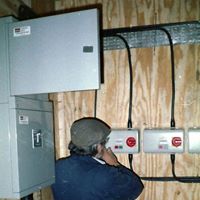What is the name of the tool in the picture?
A stud finder is a handheld device used with wood buildings to locate framing studs located behind the final walling surface, usually drywall. While there are many different stud finders available, most fall into two main categories: magnetic stud detectors and electric stud. There are also some devices employing radar.
Stud finders have been in use since the early 20th century, and the first ones were all magnetic, relying on internal magnets to detect the walling fasteners or nails presumably attached to studs. In 1977, Robert Franklin designed an electronic stud finder that relied on an internal capacitor to measure changes in density behind the walling. His patent was put into production by the "Zircon Corporation", which actually became the sole producer of electronic stud finders until the patent expired in 1998. While novel, these electronic stud finders did not always prove effective in locating studs.
Since 1998, many developments and improvements have been made to the internal capacitor stud finders and increased their popularity. Recent developments include stud finders with multiple sensor plates that sense the wall in multiple places. These sensors can indicate the location, width, and lack of studs simultaneously. With more sensors, these stud finders do not require calibration and adapt better to inconsistencies in wall construction.
More Info:
en.m.wikipedia.org







